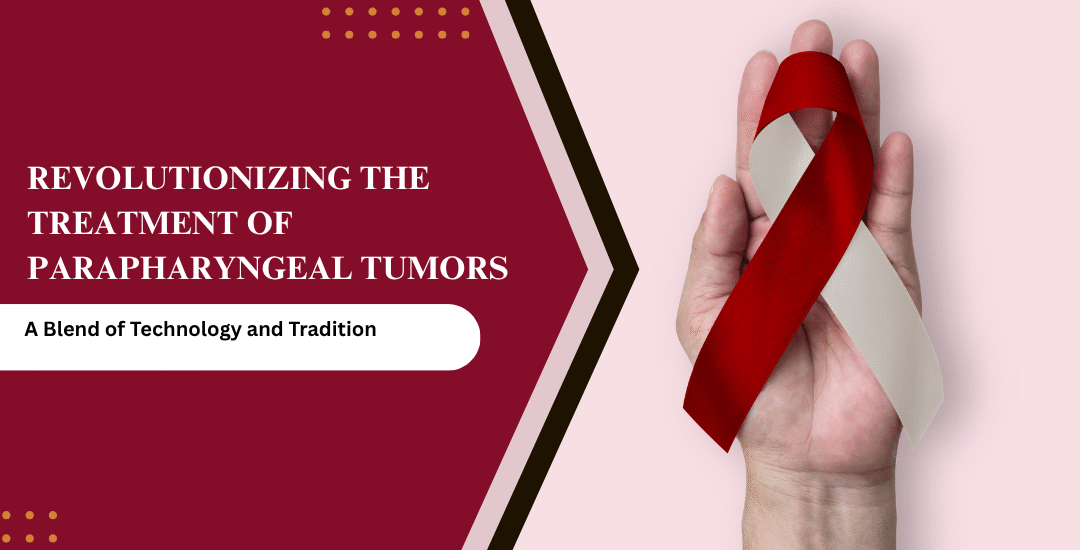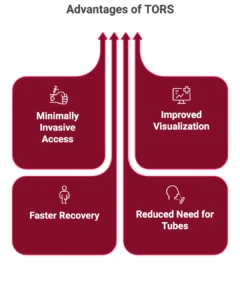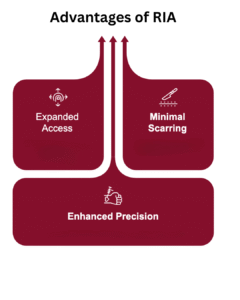Parapharyngeal tumors are among the most challenging conditions to treat in head and neck surgery. These rare tumors develop in the parapharyngeal space (PPS), a deep region near the base of the skull surrounded by critical nerves, blood vessels, and other delicate structures. While traditional open surgeries have long been the standard treatment, advancements in robotic surgery—particularly the Transoral Robotic Surgery (TORS) and the Robotic Infraclavicular Approach (RIA)—are reshaping the way these tumors are managed. In some cases, surgeons now combine these robotic approaches to achieve optimal outcomes.
This article explores how parapharyngeal tumors are treated and how robotic techniques like RIA are transforming the landscape of head and neck surgery.
The Challenges of Treating Parapharyngeal Tumors
The parapharyngeal space is a narrow, complex area located near the base of the skull. Tumors in this region are often benign but can grow to significant sizes, causing symptoms like difficulty swallowing, changes in voice, or even nerve dysfunction. The proximity of these tumors to vital structures, such as the carotid artery, internal jugular vein, and cranial nerves, makes surgical removal particularly delicate.
Conventional Open Surgery
For decades, the standard approach to treating parapharyngeal tumors involved open surgery, which required large incisions in the neck or jaw. Common techniques included:
- Mandibulotomy: Cutting through the jawbone to access the tumor.
- Cervical Approaches: Large incisions in the neck to reach the PPS.
While effective in providing surgeons access to the tumor, these open techniques came with significant drawbacks:
- Extensive scarring: Due to the large incisions.
- Higher risk of complications: Such as cranial nerve injuries, blood loss, and prolonged recovery times.
- Functional impairments: Difficulty swallowing or speaking post-surgery.
Despite these challenges, open surgery remains a vital tool in cases where tumors are exceptionally large, deeply seated, or require extensive reconstruction after removal. However, the advent of robotic surgery has provided an alternative to many patients, offering minimally invasive solutions with fewer complications.
The Role of Robotic Surgery in Treating Parapharyngeal Tumors
In recent years, robotic surgery has emerged as a game-changing option for managing parapharyngeal tumors. Two primary robotic techniques—Transoral Robotic Surgery (TORS) and the Robotic Infraclavicular Approach (RIA)—are now widely used, either independently or in combination, to provide safer, less invasive treatment options.
- Transoral Robotic Surgery (TORS)
TORS involves accessing the tumor through the mouth, avoiding the need for external incisions. This approach is particularly well-suited for tumors located in the prestyloid or retrostyloid compartments of the PPS.
Advantages of TORS
- Minimally invasive access: No need for large neck or jaw incisions.
- Improved visualization: The robotic system provides a high-definition, three-dimensional view, enabling precise tumor dissection while avoiding critical structures.
- Faster recovery: Patients experience less pain, shorter hospital stays, and quicker return to normal activities.
- Reduced need for tracheostomy or feeding tubes: Many patients can resume oral feeding shortly after surgery.
However, TORS has its limitations. For larger or more complex tumors near the skull base, access through the mouth alone may not be sufficient. This is where the Robotic Infraclavicular Approach can complement TORS.
- Robotic Infraclavicular Approach (RIA)
The Robotic Infraclavicular Approach is a newer technique that allows surgeons to access areas beneath the collarbone and near the base of the skull. This approach is especially useful for tumors that are deep-seated or located in regions that cannot be safely reached through the mouth.
Advantages of RIA:
- Expanded access: RIA provides a safe pathway to tumors near the skull base or in the lateral PPS.
- Minimal scarring: Small incisions beneath the clavicle result in better cosmetic outcomes compared to traditional open surgeries.
- Enhanced precision: Robotic systems enable surgeons to navigate complex anatomy with greater accuracy, reducing the risk of complications.
Combining TORS and RIA for Complex Cases
In some cases, surgeons combine TORS and RIA to achieve complete tumor removal. This combined approach is particularly beneficial for:
- Large tumors that extend across multiple compartments of the PPS.
- Tumors located near vital structures, where precision is critical to avoid complications.
- Cases where a single approach (TORS or RIA) might not provide adequate access.
By using TORS for tumor resection and RIA to assist with separation from critical structures, surgeons can minimize the risk of complications while ensuring complete removal of the tumor.
How Robotic Surgery Benefits Patients
Robotic techniques like TORS and RIA are transforming the treatment of parapharyngeal tumors, offering significant advantages over conventional open surgery:
- Improved Cosmetic Outcomes
Unlike traditional open surgeries that require large, visible incisions, robotic approaches minimize scarring. This is particularly important for tumors in the head and neck region, where aesthetics play a critical role in a patient’s confidence and quality of life. - Faster Recovery and Reduced Morbidity
Robotic surgery reduces surgical trauma, leading to shorter hospital stays, less postoperative pain, and quicker recovery times. Many patients are back to their normal routines within weeks. - Preservation of Function
The precision of robotic systems helps preserve critical structures, such as cranial nerves, reducing the risk of functional impairments like difficulty swallowing or speaking. - Minimized Need for Tracheostomy and Feeding Tubes
Patients undergoing robotic surgery often avoid the need for tracheostomies or prolonged reliance on feeding tubes, significantly improving their postoperative quality of life. - Expanded Treatment Options
For patients who were previously considered inoperable due to the size or location of their tumors, the combination of TORS and RIA provides new possibilities for safe and effective treatment.
Conclusion
The treatment of parapharyngeal tumors has undergone a remarkable transformation with the advent of robotic surgery. While conventional open surgeries remain an essential tool for certain cases, techniques like Transoral Robotic Surgery (TORS) and the Robotic Infraclavicular Approach (RIA) offer minimally invasive solutions with fewer complications and improved outcomes. In some cases, the combination of these approaches provides the best of both worlds, allowing surgeons to tackle even the most complex tumors with precision and confidence.
For patients, these advances mean shorter recovery times, better cosmetic results, and a higher quality of life after surgery. As robotic technology continues to evolve, the future of parapharyngeal tumor management is brighter than ever, bringing hope to those facing these challenging conditions.
This article integrates the role of conventional surgery, robotic techniques, and their combination while maintaining accessibility for the general public. Let me know if you’d like to tailor it further!



